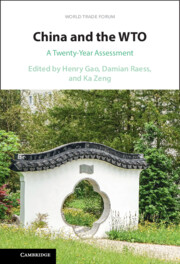Acknowledgments
This volume would not have been possible without the support of the Robert Schuman Centre for Advanced Studies at the European University Institute (EUI) and the World Trade Institute (WTI) at the University of Bern and, in particular, of Manfred Elsig, Joseph Francois, Bernard Hoekman, and Peter Van den Bossche. Damian Raess is grateful for the financial support of the Swiss National Science Foundation Grant Agreements No PP00P1_198904 and, for the open access publication, No 10BP12_216907.
We further wish to thank Alexandra Eugster and Christian Steiger of the WTI for their excellent logistical support, as well as Marianne Nield, Rachel Imrie, and Sharon McCann from Cambridge University Press for their guidance throughout the entire process and continued support for the World Trade Forum.
In particular, we wish to thank Chris Hudson at Cambridge University Press for working with the designers to create the perfect artwork for the book, which shows the gate to the Gusu Garden in the courtyard of Centre William Rappard, with parts of the main building of the WTO in the background. Donated to the WTO by the Chinese government in 2013, the Gusu Garden is based on the traditional Chinese garden and represents a symbol of China’s engagement and commitment to the WTO. The two Chinese characters inscribed at the top of the gate are “Enter” and “Win”, which shows China’s determination not only to win the battle of its accession negotiation, but also to win in international competition after accession. Together, the two characters form another term: “Wonderland”, which was how China regarded the WTO, at least until the Gusu Garden was built.Footnote 1
1 See Henry Gao, China’s Changing Perspective on the WTO: From Aspiration, Assimilation to Alienation.
